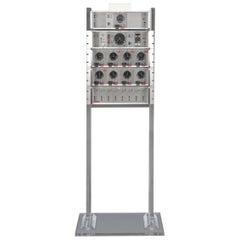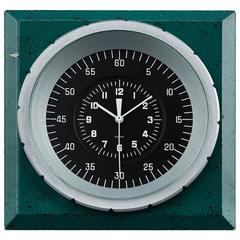Patek Philippe Electronic
Recent Sales
20th Century Swiss Industrial Scientific Instruments
Metal
20th Century Swiss Scientific Instruments
Patek Philippe Electronic For Sale on 1stDibs
How Much is a Patek Philippe Electronic?
Patek Philippe for sale on 1stDibs
It shouldn’t be surprising that a Patek Philippe holds the world auction record for a watch ($31.2 million for a Patek Grandmaster Chime, sold at Christie’s). Known for impeccable craftsmanship and some of the most complicated timepieces ever created, the brand is considered by many to be the height of fine watchmaking. Collectors simply love Patek Philippe watches.
The house was founded in Geneva in 1839 by Polish expats Antoni Patek and Franciszek Czapek. Czapek left the firm, and in 1845, Patek partnered with French watchmaker Jean Adrien Philippe. It was the beginning of a beautiful friendship.
Catering to the glitterati of Europe, the pair counted among their clients Tolstoy, Pope Pius IX and Queen Victoria, as well as Countess Koscowicz of Hungary, for whom they created the first Swiss-made wristwatch in 1868. They also had their eye on the American market and in 1851 entered an arrangement with Tiffany & Co. still in effect today.
During the Great Depression, brothers Jean and Charles Stern, who had previously supplied Patek Philippe with watch dials, bought the company, and it continues to be run by the Stern family today.
Under the Sterns, the house has developed some of its most famous models, including the Calatrava, an elegantly minimal dress watch introduced in 1932 and named for the Calatrava Cross (the company’s logo since 1887), and the Nautilus, the brand’s first sports watch, conceived by legendary designer Gérald Genta in 1976.
Despite the house’s longevity, it’s rumored that it has manufactured fewer than a million Patek watches, making each one all the more coveted. (The brand's pieces are understandably attractive to counterfeiters — make sure you know how to spot a fake Patek Philippe watch.)
Find authentic Patek Philippe watches, cufflinks, bracelets and more on 1stDibs today.
- 1stDibs ExpertDecember 17, 2024The country in which Patek Philippe is made is Switzerland. The house was founded in Geneva in 1839 by Polish expats Antoni Patek and Franciszek Czapek. Czapek later left the firm, and in 1845, Patek partnered with French watchmaker Jean Adrien Philippe. Shop a large selection of Patek Philippe watches on 1stDibs.
- 1stDibs ExpertDecember 17, 2024Who the designer of Patek Philippe is has varied over the years. Early in the Swiss luxury watchmaker's history, its founders, Antoni Patek and Jean Adrien Philippe, served as its designers. After Patek and Philippe, the most notable designer who worked for the company was Gérald Genta, the creator of the iconic Nautilus. Other notable Patek Philippe designers include Eric Giroud, Jean-Pascal Poinçot and Gilbert Albert. On 1stDibs, shop a diverse assortment of Patek Philippe watches.
- 1stDibs ExpertDecember 17, 2024The old name for Patek Philippe was Patek, Czapek & Cie. It was founded in Geneva in 1839 by Polish expats Antoni Patek and Franciszek Czapek. After Czapek exited the firm and Patek partnered with French watchmaker Jean Adrien Philippe, the company was renamed Patek, Philippe & Cie in 1851. Eventually, the Cie name was dropped altogether. Shop a diverse assortment of Patek Philippe watches on 1stDibs.
- What made Patek Philippe famous?1 Answer1stDibs ExpertDecember 17, 2024What made Patek Philippe famous was the Swiss luxury watchmaker's incredible innovation. In 1876, Patek Philippe introduced the first-minute repeater, and in 1923, it unveiled one of the first-ever chronograph timepieces. Another significant achievement of the watchmaker was the first perpetual calendar, which debuted on a Patek Philippe watch in 1925. Shop a large collection of Patek Philippe watches on 1stDibs.
- 1stDibs ExpertMay 5, 2023Yes, Patek Philippe is older than Rolex. The Swiss luxury watchmaker opened in Geneva in 1839. Rolex was founded 66 years later in 1905 in London, UK. In 1908, Rolex founder Hans Wilsdorf trademarked the name Rolex, and by 1920, he had moved the company to Geneva and redubbed it as Montres Rolex S.A. On 1stDibs, shop a range of vintage Patek Philippe watches and Rolex watches from some of the world’s top sellers.
- 1stDibs ExpertFebruary 1, 2024What is so special about Patek Philippe comes down mostly to the quality of the timepieces that the watchmaker produces. Skilled artisans make each watch entirely by hand, with a process that can take nine months for a very basic timepiece or up to two years for highly complex watches. The Swiss watchmaker also uses fine materials like precious metals and has a reputation for engineering very precise movements for timekeeping. On 1stDibs, shop a collection of Patek Philippe watches.
- 1stDibs ExpertFebruary 22, 2021Some of the less expensive Patek Philippe watches are priced between $19,000 and $30,000 USD. Within this price range, buyers can choose from Calatrava, Nautilus and Aquanaut. There are plenty of Patek Philippe watches to choose from on 1stDibs.
- 1stDibs ExpertDecember 5, 2024No one knows for sure how many Patek Philippe watches are made each year. However, most experts estimate that the Swiss luxury watchmaker produces around 60,000 watches annually. It’s rumored that the company has manufactured fewer than a million Patek watches, making each one all the more coveted. Shop a collection of Patek Philippe watches on 1stDibs.
- 1stDibs ExpertNovember 22, 2024How much a Patek Philippe Geneve watch is in dollars varies. Prices depend on its materials, number and type of complications, model, availability and other factors. Generally, starting prices are between $20,000 and $25,000, and the highest-priced timepieces produced by the Swiss luxury watchmaker cost upwards of $500,000. On 1stDibs, shop a wide range of Patek Philippe watches.
- 1stDibs ExpertNovember 22, 2024How much an entry-level Patek Philippe watch costs varies based on materials, model, availability and other characteristics. However, most entry-level timepieces produced by the luxury watchmaker are priced from $20,000 to $25,000. Some entry-level models include the Calatrava 5196, the Aquanaut 5167A, the Twenty-4 4910/10A and the Gondolo 5124. Find a variety of Patek Philippe watches on 1stDibs.
- 1stDibs ExpertNovember 22, 2024Here is a brief history of Patek Philippe watches. The house was founded in Geneva in 1839 by Polish expats Antoni Patek and Franciszek Czapek. Czapek later left the firm, and, in 1845, Patek partnered with French watchmaker Jean Adrien Philippe.
Catering to the glitterati of Europe, the pair counted among their clients Tolstoy, Pope Pius IX and Queen Victoria, as well as Countess Koscowicz of Hungary, for whom they created the first Swiss-made wristwatch in 1868. They also had their eye on the American market and, in 1851, entered into an arrangement with Tiffany & Co., still in effect today. During the Great Depression, brothers Jean and Charles Stern, who had previously supplied Patek Philippe with watch dials, bought the company, and it continues to be run by the Stern family today.
Under the Sterns, the house has developed some of its most famous models, including the Calatrava, an elegantly minimal dress watch introduced in 1932 and named for the Calatrava Cross (the company’s logo since 1887), and the Nautilus, the brand’s first sports watch, conceived by legendary designer Gérald Genta in 1976. Despite the house’s longevity, it’s rumored that it has manufactured fewer than a million watches, making each one all the more coveted.
On 1stDibs, find vintage Patek Philippe watches for sale. - 1stDibs ExpertDecember 17, 2024What the entry-level price for a Patek Philippe watch is depends on the model, materials and other factors. Generally, price points for the Swiss luxury maker’s entry-level new watches are between $15,000 and $30,000. However, some pre-owned models sold on trusted online platforms, like 1stDibs, may be offered for less. On 1stDibs, explore a wide range of Patek Philippe watches.
- 1stDibs ExpertDecember 17, 2024What the most sought-after Patek Philippe model is will likely vary over time as the Swiss luxury watchmaker continues to unveil new timepieces. However, one of the rarest watches made by the company is the one-of-a-kind Grand Complication Ref. 6300A-010, which sold for $31 million at auction in 2016. Another highly sought-after watch is the Nautilus Ref. 5711/1A Tiffany Blue, a limited edition watch produced in collaboration with Tiffany & Co. On 1stDibs, shop a wide range of Patek Philippe watches.
- 1stDibs ExpertApril 5, 2022All of Patek Philippe’s watch models are collector’s items and popular in their own right. The widely coveted Nautilus sports watch line, for example, has been produced without interruption for more than four decades, but it’s hard to say which of the brand’s watches is the most popular because different models cater to different needs and preferences. On 1stDibs, you’ll find a variety of expertly-vetted vintage and contemporary Patek Philippe watches from some of the world’s top sellers.
- 1stDibs ExpertApril 5, 2022Yes, Patek Philippe watches hold their value very well due to their immense popularity among collectors. Patek Philippe is one of the world's premier watchmakers with over 150 years of experience. On 1stDibs, find a collection of vintage and contemporary Patek Philippe watches.
- 1stDibs ExpertFebruary 22, 2021Patek Philippe watches are commonly seen as the best brand for Swiss watches, particularly because of their quality, level of expertise, and value. In the manufacturing process there are often 60 steps needed even for subtle aspects which also adds to the cost.
- 1stDibs ExpertDecember 12, 2023What the Patek Philippe logo means has a range of interpretations. Some people equate it with power. Others see it as a symbol of prestige, wealth or strength. What isn't up for debate is what inspired the logo called the Calatrava. The emblem appeared on the banners of the Calatrava knights, who defended the Spanish city of Calatrava from Arabian invaders during the 12th century. Shop a wide variety of Patek Philippe watches on 1stDibs.
Read More
Patek Philippe’s Calatrava Watch Is an Icon of Understated Elegance
Launched in 1932, the model has become emblematic of quality craftsmanship and timeless design.
Globe Hopper? This Patek Philippe Watch Can Give You the Time in 24 Cities
A true icon of the much-coveted category of World Time watches, this rare model represents an important milestone in the history of one of the brand's signature complications.
How to Tell If a Watch Was Actually Made in Geneva
Just because the dial says Geneva — or the alluring French version of the city's name, Genève — it doesn’t mean your timepiece was crafted in the watchmaking capital.
The 14 Most Iconic Watches for Women
Style, craft and heritage combine to make these designs undeniable classics.
Stylish Year-Round, This Pumpkin-Colored Patek Philippe Aquanaut Feels Especially Right for Fall
Celebrate the season with a Patek watch made for enjoying the outdoors.
Get a Glimpse at One of the Most Valuable Watch Collections in the World
As the cache goes on display at London’s Design Museum, we speak to its enigmatic owner about some of his rarest acquisitions.
The 6 Most Popular Brands for Luxury Watches
These companies have stood the test of time, making exceptional pieces for generations.
The Personal Luxury Goods Market amid COVID-19
1stDibs dealers discuss the challenges of this unprecedented time, and the signs of hope.

